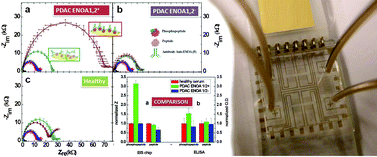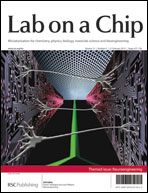Pancreatic ductal adenocarcinoma (PDAC) is one of the most aggressive and lethal cancers in Europe and the United States. It has a very low 5 years-survival rate and its diagnosis is often late and imprecise due to the lack of specificity of currently used markers for PDAC. As previously demonstrated PDAC patients’ sera may contain autoantibodies towards phosphorylated α-enolase (ENOA), which in combination with other standard markers can increase specificity in diagnosis of PDAC. In this context we realized a microfluidic platform with integrated EIS biosensors. We achieved a specific antibodies detection by immobilizing onto electrodes peptides corresponding to a portion of ENOA. Phosphorylation of peptides was found to influence the recognition of antibodies in PDAC patients’ sera detected by the developed biochip thus validating the EIS technique as a strong tool for quick, cost-saving and label-free analysis of serum samples. Biochip results are in agreement with those from traditional techniques, such as ELISA and western blot, but measurements are much more sensitive and specific, increasing the possibility of PDAC diagnosis. In addition this approach is faster and more reproducible compared to traditional techniques making the developed biochips ideal for a quick, cost-saving and label-free analysis of serum samples.

You have access to this article
 Please wait while we load your content...
Something went wrong. Try again?
Please wait while we load your content...
Something went wrong. Try again?


 Please wait while we load your content...
Please wait while we load your content...